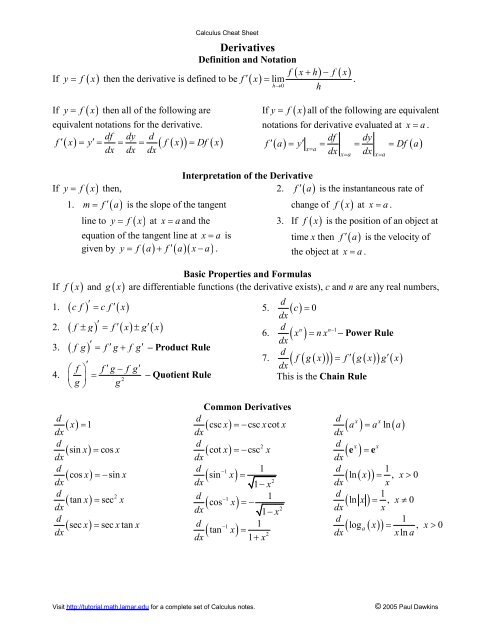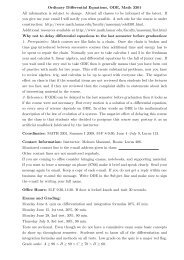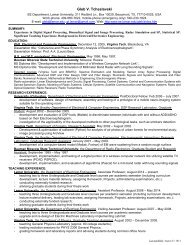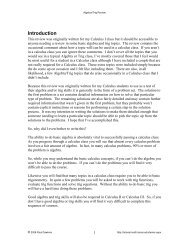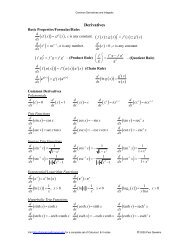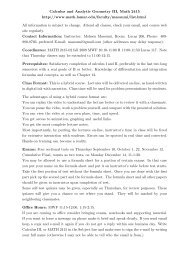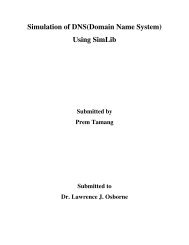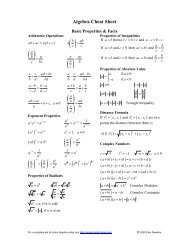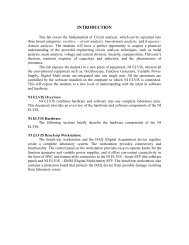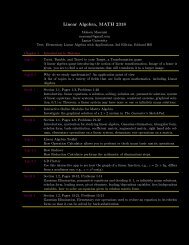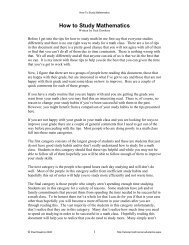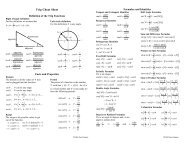Calculus Cheat Sheet Derivatives - Pauls Online Math Notes
Calculus Cheat Sheet Derivatives - Pauls Online Math Notes
Calculus Cheat Sheet Derivatives - Pauls Online Math Notes
- No tags were found...
You also want an ePaper? Increase the reach of your titles
YUMPU automatically turns print PDFs into web optimized ePapers that Google loves.
<strong>Calculus</strong> <strong>Cheat</strong> <strong>Sheet</strong><strong>Derivatives</strong>Definition and NotationIf y = f ( x)then the derivative is defined to be f ( x)( + ) - ( )¢ = .hh ® 0flimx h f xIf y = f ( x)then all of the following areequivalent notations for the derivative.df dy df¢ ( x) = y¢= = = f ( x)= Df xdx dx dx( ) ( )If y = f ( x)all of the following are equivalentnotations for derivative evaluated at x= a.df dyf¢ ( a) = y¢= = = Df ( a)x=adx dxx= a x=aIf y = f ( x)then,1. m f¢( a)= is the slope of the tangentline to y = f ( x)at x= aand theequation of the tangent line at x= a isy = f a + f¢a x- a .given by ( ) ( )( )If f ( x ) and ( )¢ ¢1. ( cf ) = cf ( x)Interpretation of the Derivativef¢ a is the instantaneous rate of2. ( )change of f ( x ) at x= a.3. If f ( x ) is the position of an object attime x then f¢ ( a)is the velocity ofthe object at x= a.Basic Properties and Formulasg x are differentiable functions (the derivative exists), c and n are any real numbers,¢ ¢ ¢2. ( f ± g) = f ( x) ± g ( x)3. ( )fg ¢ = f¢ g+ fg¢– Product Ruleæ f ö¢f¢ g-fg¢4. ç ÷ =– Quotient Rule2è g ø gddxd xn nxn-= – Power Ruledxd( f ( g x )) = f¢ g( x)g¢xdxThis is the Chain Rule5. ( c ) = 06. ( )17. ( )( ) ( )ddxddxddxddxddx( x ) = 1( sinx)( cosx)= cos x=- sin x2( tanx) = sec( )xsecx = secxtanxCommon <strong>Derivatives</strong>d( cscx)=- cscxcotxdxd2( cotx) =- csc xdxd -11( sin x)=dx21-xd -11( cos x)=-dx21-xd -11( tan x)2dx 1 xd a a ax x( ) = ln ( )dxd x x( e ) = edxd 1( ( x)) xdx xd 1( x ) xdx xd= ( a ( x))+ln = , > 0ln = , ¹ 01log = , x>0dx xlnaVisit http://tutorial.math.lamar.edu for a complete set of <strong>Calculus</strong> notes.© 2005 Paul Dawkins
<strong>Calculus</strong> <strong>Cheat</strong> <strong>Sheet</strong>Chain Rule VariantsThe chain rule applied to some specific functions.dnn-1d1. ( éf ( x)ù ) = néf ( x) ù f¢( x)dxë û ë û5. ( coséf ( x)) f ( x) sin f ( x)dxë ùû =- ¢ éë ùûd f ( x)f ( x)d22. ( e ) = f¢( x)e6. ( tanéf ( x)) f ( x) sec f ( x)dxdxë ùû = ¢ éë ùûdf¢( x)d3. ( ln éf( x)ù)=7. secdxë û[ ] = ¢ sec tanf ( x)dxdd 1f ( x)4. ( sinéf ( x)ù) = f¢( x) cos éf ( x)ù8. ( tan- éf( x))¢2dxë û ë û dxë ùû=1+éëf ( x)ùû( f ( x) ) f ( x) [ f ( x) ] [ f ( x)]Higher Order <strong>Derivatives</strong>The Second Derivative is denoted asThe n th Derivative is denoted as2n( 2( ) ) d f( nf¢¢ x = f ( x)= and is defined as) d ff2( x)= and is defined asndxdxf¢¢ ( x) = f¢( x )¢nn- 1, i.e. the derivative of the¢f x = f x , i.e. the derivative of( )¢ .first derivative, f ( x)( )( )(()( ))the (n-1) st derivative, f( n-1)( x)Implicit Differentiation+ xy = sin y + 11xy = y x here, so products/quotients of x and y2x-9y3 2Find y¢ if e ( ) . Remember ( )will use the product/quotient rule and derivatives of y will use the chain rule. The “trick” is todifferentiate as normal and every time you differentiate a y you tack on a y¢ (from the chain rule).After differentiating solve for y¢.e( y¢ )exy xyy¢ ( y)y¢( )-x- ey- ( ) ¢ = -x-ey-2x-9y2 2 32- 9 + 3 + 2 = cos + 11- y¢ + xy + xyy¢ = y y¢ + Þ y¢=2x-9y 2x-9y2 2 32e9 3 2 cos 11( )2xy 9 cos y y 11 2 3xy3 2 9 2 9 2 2Critical Pointsx c= is a critical point of f ( )1. f¢ ( c) = 0 or 2. f ( c)Increasing/Decreasing – Concave Up/Concave Down¢ doesn’t exist.x provided eitherIncreasing/Decreasing1. If f¢ ( x) > 0 for all x in an interval I thenf ( x ) is increasing on the interval I.¢ < for all x in an interval I then2. If f ( x) 0f ( x ) is decreasing on the interval I.¢ = for all x in an interval I then3. If f ( x) 0f ( x ) is constant on the interval I..2x-9y2 211-2e-3xy3 2x-9y2xy-9e-cos( y)Concave Up/Concave Down1. If f¢¢ ( x) > 0 for all x in an interval I thenf ( x ) is concave up on the interval I.¢¢ < for all x in an interval I then2. If f ( x) 0f ( x ) is concave down on the interval I.Inflection Pointsx c= is a inflection point of f ( )concavity changes at x= c.x if theVisit http://tutorial.math.lamar.edu for a complete set of <strong>Calculus</strong> notes.© 2005 Paul Dawkins
Absolute Extrema1. x c= is an absolute maximum of f ( x )if f ( c) ³ f ( x)for all x in the domain.= is an absolute minimum of f ( x )2. x cif f ( c) £ f ( x)for all x in the domain.Fermat’s Theoremf x has a relative (or local) extrema atIf ( )x= c, then x c= is a critical point of ( )<strong>Calculus</strong> <strong>Cheat</strong> <strong>Sheet</strong>f x .Extreme Value Theoremf x is continuous on the closed intervalIf ( )[ ab , ] then there exist numbers c and d so that,1. a£ cd , £ b, 2. f ( c ) is the abs. max. in[ ab , ] , 3. ( )f d is the abs. min. in [ , ]ab .Finding Absolute ExtremaTo find the absolute extrema of the continuousab , use thefunction f ( x ) on the interval [ ]following process.1. Find all critical points of f ( x ) in [ ab , ] .2. Evaluate f ( x ) at all points found in Step 1.3. Evaluate f ( a ) and f ( b ) .4. Identify the abs. max. (largest functionvalue) and the abs. min.(smallest functionvalue) from the evaluations in Steps 2 & 3.ExtremaRelative (local) Extrema1. x= c is a relative (or local) maximum off c ³ f x for all x near c.f ( x ) if ( ) ( )2. x= c is a relative (or local) minimum off c £ f x for all x near c.f ( x ) if ( ) ( )1 st Derivative TestIf x c= is a critical point of ( )1. a rel. max. of f ( x ) if f ( x) 0f x then x= c is¢ > to the leftof x= c and f¢ ( x) < 0 to the right of x= c.2. a rel. min. of f ( x ) if f ( x) 0¢ < to the leftof x= cand f¢ ( x) > 0to the right of x= c.¢ is3. not a relative extrema of f ( x ) if f ( x)the same sign on both sides of x2 nd Derivative TestIf x cMean Value Theorem,= c.= is a critical point of f ( x ) such thatf¢ ( c) = 0 then x=c1. is a relative maximum of f ( x ) if f ( c) 02. is a relative minimum of f ( x ) if f ( c) 03. may be a relative maximum, relativeminimum, or neither if f¢¢ ( c) = 0 .Finding Relative Extrema and/orClassify Critical Points1. Find all critical points of f ( x ) .2. Use the 1 st derivative test or the 2 ndderivative test on each critical point.¢¢ < .¢¢ > .If f ( x ) is continuous on the closed interval [ ab ] and differentiable on the open interval ( ab , )f ( b) - f ( a)then there is a number a< c< b such that f¢ ( c)=.b-aNewton’s MethodIf xnis the n th guess for the root/solution of f ( x ) = 0 then (n+1) st guess isprovided f¢ ( x n ) exists.xxf= - n+ 1 n¢f( xn)( x )nVisit http://tutorial.math.lamar.edu for a complete set of <strong>Calculus</strong> notes.© 2005 Paul Dawkins
<strong>Calculus</strong> <strong>Cheat</strong> <strong>Sheet</strong>Related RatesSketch picture and identify known/unknown quantities. Write down equation relating quantitiesand differentiate with respect to t using implicit differentiation (i.e. add on a derivative every timeyou differentiate a function of t). Plug in known quantities and solve for the unknown quantity.Ex. A 15 foot ladder is resting against a wall.The bottom is initially 10 ft away and is beingpushed towards the wall at 1 4ft/sec. How fastis the top moving after 12 sec?Ex. Two people are 50 ft apart when onestarts walking north. The angleθ changes at0.01 rad/min. At what rate is the distancebetween them changing when θ = 0.5 rad?x¢ is negative because x is decreasing. UsingPythagorean Theorem and differentiating,2 2 2x + y = 15 Þ 2xx¢ + 2yy¢= 01After 12 sec we have ( )x = 10- 12 = 7and4We have θ¢ = 0.01 rad/min. and want to findx¢ . We can use various trig fcns but easiest is,xx¢secθ = Þ secθ tanθθ¢=50 50We knowθ = 0.05 so plug in θ¢ and solve.x¢sec( 0.5) tan( 0.5)( 0.01)=50x¢ = 0.3112 ft/secRemember to have calculator in radians!2 2so y = 15 - 7 = 176 . Plug in and solvefor y¢.717( -4 ) + 176 y¢ = 0 Þ y¢= ft/sec4 176OptimizationSketch picture if needed, write down equation to be optimized and constraint. Solve constraint forone of the two variables and plug into first equation. Find critical points of equation in range ofvariables and verify that they are min/max as needed.Ex. We’re enclosing a rectangular field with500 ft of fence material and one side of thefield is a building. Determine dimensions thatwill maximize the enclosed area.Ex. Determine point(s) on yclosest to (0,2).2= x + 1 that areMaximize A= xy subject to constraint ofx+ 2y= 500 . Solve constraint for x and pluginto area.A= y( 500-2y)x= 500-2yÞ=2500y- 2yDifferentiate and find critical point(s).A¢ = 500-4y Þ y = 125By 2 nd deriv. test this is a rel. max. and so isthe answer we’re after. Finally, find x.x = 500- 2125 = 250( )The dimensions are then 250 x 125.2 22Minimize f d ( x 0) ( y 2)constraint is= = - + - and they2= x + 1. Solve constraint for2x and plug into the function.2 2x y f x y( )= -1 Þ = + -22( )2 2= y- 1+ y- 2 = y - 3y+3Differentiate and find critical point(s).3f¢ = 2y-3Þ y =2By the 2 nd derivative test this is a rel. min. andso all we need to do is find x value(s).2 3 1 1x = - 1 = Þ x=±2 2 21 3The 2 points are then ( , 2 2 ) and ( - 1, 32 2 )Visit http://tutorial.math.lamar.edu for a complete set of <strong>Calculus</strong> notes.© 2005 Paul Dawkins


